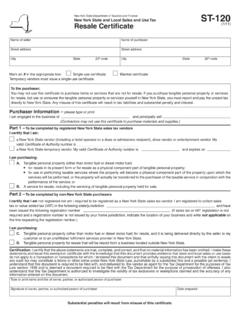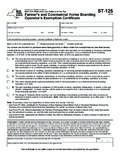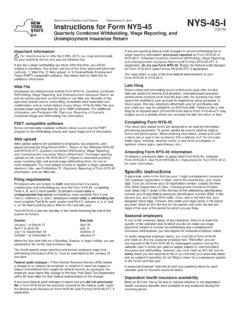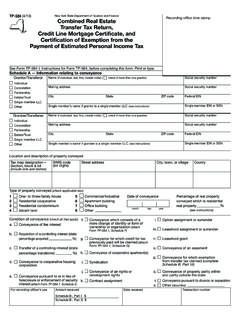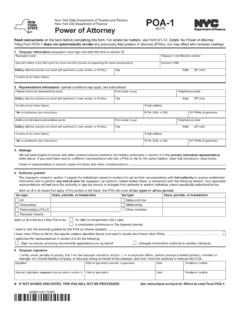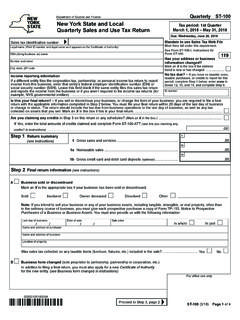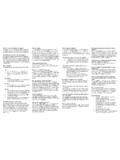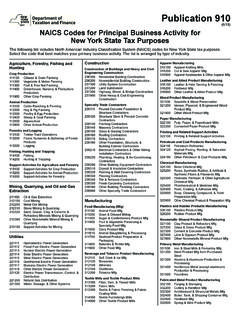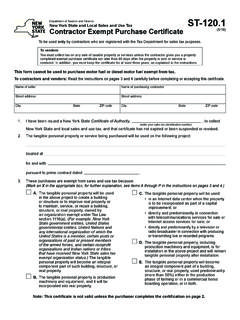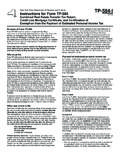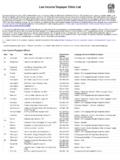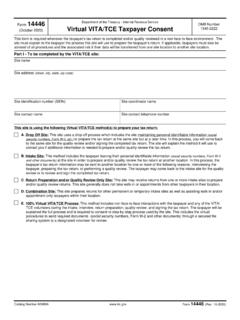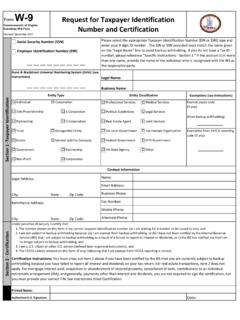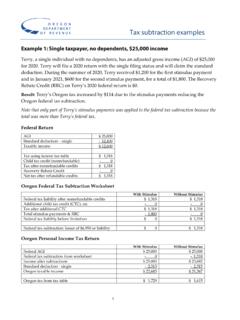Transcription of New York State Department of Taxation and Finance …
1 TSB-M-98(7)IIncome TaxDecember 24, 1998 New York State Department of Taxation and FinanceTaxpayer Services DivisionTechnical Services BureauNew York Tax Treatment ofRoth IRAsThe Tax Department has been asked to issue guidance concerning the tax treatment of RothIRAs, and conversions of traditional IRAs to Roth IRAs, for New York State , New York City, andYonkers personal income tax purposes. This Memorandum discusses that treatment, and coversresidents and nonresidents, application of the New York accrual rules for part-year residents, anduse of the $20,000 New York pension York State , New York City, and Yonkers ResidentsNew York conforms in all respects to the federal income tax treatment of Roth , the following federal income tax rules apply in computing the New York State andNew York City resident personal income taxes and the Yonkers resident personal income taxsurcharge: Contributions.
2 Contributions to a Roth IRA are not deductible. Account Income. Income earned in a Roth IRA account is tax-deferred while held in theaccount. Distribution Income. Income distributed from a Roth IRA is exempt from tax if it is exemptfrom federal income tax. If a Roth IRA distribution is subject to federal tax because it was nota qualified distribution, it is also subject to State and city taxes. In this Memorandum, thesetaxable income distributions will be referred to as distribution income. Conversion Income. Income attributable to the rollover or conversion of a traditional IRAto a Roth IRA is taxable to the same extent as for federal income tax purposes. Furthermore,if the rollover or conversion takes place before January 1, 1999, and the taxpayer elects toreport the income over a four-year period for federal purposes, the taxpayer will report theincome over a four-year period for State and city purposes. In this Memorandum, the taxableincome from a rollover or conversion will be referred to as conversion York State NonresidentsAs to New York State nonresidents, the above rules for residents apply in computing New Yorkadjusted gross income.
3 New York adjusted gross income is used to compute the base tax (the taxas if a resident), and it is also the denominator of the income percentage. The numerator of theincome percentage is New York source income. New York source income does not include Roth TSB-M-98(7)IIncome TaxDecember 24, 1998-2-IRA amounts. Such amounts, both distribution income and conversion income, are excluded byreason of section 114 of Title 4 of the Code (relating to limitation on State income Taxation ofpension income.)New York City and Yonkers NonresidentsThe New York City and Yonkers nonresident earnings taxes are computed only on wages andnet earnings from self-employment. Accordingly, Roth IRA amounts are not included in thecomputation of those York State , New York City, and Yonkers Part-Year ResidentsIf a taxpayer changes New York resident status during the year, the nonresident rules discussedabove generally apply, with three modifications: Distribution income, and conversion income not subject to the federal four-year spread, areincluded in New York source income if the income is received or recognized while the taxpayer is a resident.
4 If the taxpayer converts a traditional IRA to a Roth IRA prior to changing residence, and electsthe federal four-year spread, for New York purposes the entire conversion income is accruedto the period prior to the residence change. In the case of a reconversion of a traditional IRA to a Roth IRA, the date of the lastreconversion is used to determine the period (resident or nonresident) in which the conversionoccurs. However, if the reconversion is an excess reconversion ( , the taxpayer exceededthe number of allowed reconversions) for federal income tax purposes, the date of the last priorvalid reconversion is part-year resident rules are discussed in more detail below. The rules also apply indetermining the period (resident or nonresident) in which the IRA income is recognized if a taxpayerchanges residence status for New York City or Yonkers tax purposes. (However, as discussed underNew York City and Yonkers Nonresidents above, IRA income recognized in the city nonresidentperiod is not subject to city tax.)
5 Distribution Income. If a taxpayer receives a taxable distribution from a Roth IRA duringthe change-of-residence year, the distribution income is included in New York adjusted grossincome for the change year. If the distribution is received in the resident period, the distributionincome is also included in New York source income. If the distribution is received in thenonresident period, the distribution income is not included in New York source income. TSB-M-98(7)IIncome TaxDecember 24, 1998-3-Conversion Income. Immediate Recognition. If a taxpayer converts a traditional IRA toa Roth IRA during the change-of-residence year, and does not qualify or does not elect to report theconversion income over a four-year period, the entire conversion income is included in New Yorkadjusted gross income for the change year. If the conversion occurs during the resident period, theentire conversion income is also included in New York source income.
6 If the conversion occursduring the nonresident period, none of the conversion income is included in New York sourceincome. Conversion Income. Four-Year Spread. If a taxpayer converts a traditional IRA to a RothIRA, elects to report the income over a four-year period for federal income tax purposes, andchanges residence during any of the four years, the New York accrual rules may apply. However,the New York accruals do not have to be made if the taxpayer posts a bond or other acceptablesecurity with the Tax Department . (For more information on the New York accruals, see TSB-M-94-(9)I.) The New York accrual rules apply to conversion income where the four-year spread iselected as follows: Resident to NonresidentConversion in Resident PeriodAccrualIf the taxpayer changes status from resident to nonresident, and the conversiontakes place during the resident period, the entire conversion income reportable for federal purposesover the four-year period is accrued to the resident period, and accordingly included in both NewYork adjusted gross income and New York source income.
7 This rule applies if the conversionoccurs in the change-of-residence year. If the residence change occurs in a year following theconversion year, the accrual applies only to the remaining conversion income that is reportable forfederal income tax 1: On March 1, 1998, a taxpayer converts a $40,000 traditional IRA to a Roth IRAand elects to report the income over a four-year period for federal income tax purposes. Thetaxpayer changes status from resident to nonresident on July 1, 1998. The taxpayer mustaccrue the conversion income to the resident period, and accordingly would include the$40,000 conversion income in both New York adjusted gross income and New York sourceincome in 2: If the taxpayer in Example 1 moves out of New York in 1999 rather than 1998,the taxpayer would report $10,000 conversion income as a resident in 1998. In the 1999change year, the taxpayer would include in New York adjusted gross income and New Yorksource income the remaining $30,000 conversion 3: If the taxpayer in Example 1 had elected to post a bond or other security, the NewYork accrual would not be made, and the taxpayer would file a New York return and include$10,000 of the conversion income in New York adjusted gross income and New York sourceincome for each of the four years 1998 through (7)IIncome TaxDecember 24, 1998-4- Resident to NonresidentConversion in Nonresident PeriodNo AccrualIf the taxpayer changes status from resident to nonresident, and the conversiontakes place in the nonresident period, accrual does not apply.
8 The taxpayer would include in NewYork adjusted gross income the same amount included in federal adjusted gross income for the year,and no part of the federal amount would be included in New York source income. This rule appliesto the change-of-residence year. It also applies to any subsequent nonresident years in the four-yearperiod for which the taxpayer is required to file a New York return. Nonresident to ResidentConversion in Nonresident PeriodIf the taxpayer changes status from nonresident to resident, and the conversion takes placeduring the nonresident period, accrual depends on whether the traditional IRA is related to NewYork employment. IRA Not Related to New York EmploymentAccrual If the IRA is not related to employment in New York, accrual applies. Theentire conversion income reportable for federal purposes over the four-year period is accruedto the nonresident period, and accordingly is included in New York adjusted gross income.
9 No amount is included in New York source income. In addition, because of the accrual, noneof the conversion income is included for New York purposes in the subsequent years of thefederal four-year spread. These rules apply if the conversion occurs in the change-of-residenceyear. If the residence change occurs in a year following the conversion year, the accrualapplies only to the remaining conversion income that is reportable for federal income 4: On May 12, 1998, a taxpayer converts a $40,000 traditional IRA to a Roth taxpayer changes status from New York nonresident to New York resident on August 1,1998. The traditional IRA is not related to employment in New York. The taxpayer mustaccrue the conversion income to the nonresident period. Accordingly, the taxpayer wouldinclude in New York adjusted gross income the $40,000 conversion income, and no amountof the conversion income would be included in New York source income.
10 In addition, becauseof the accrual to 1998, the $10,000 conversion income reported in federal income in each ofthe three years 1999 through 2001 is excluded from New York income in those 5: If the taxpayer in Example 4 moves into New York in 1999 rather than 1998, thetaxpayer would include in his or her 1999 New York adjusted gross income but not in NewYork source income the $30,000 remaining conversion income. In addition, because of the1999 accrual, the $10,000 conversion income reported in federal income in each of the twoyears 2000 and 2001 is excluded from New York income in those years. IRA Related to New York EmploymentNo Accrual If the IRA is related to New York employment, accrual does not apply. TheTSB-M-98(7)IIncome TaxDecember 24, 1998-5- taxpayer would include in New York adjusted gross income the same amount included infederal adjusted gross income. No amount is included in New York source income since theconversion takes place during the nonresident period.
